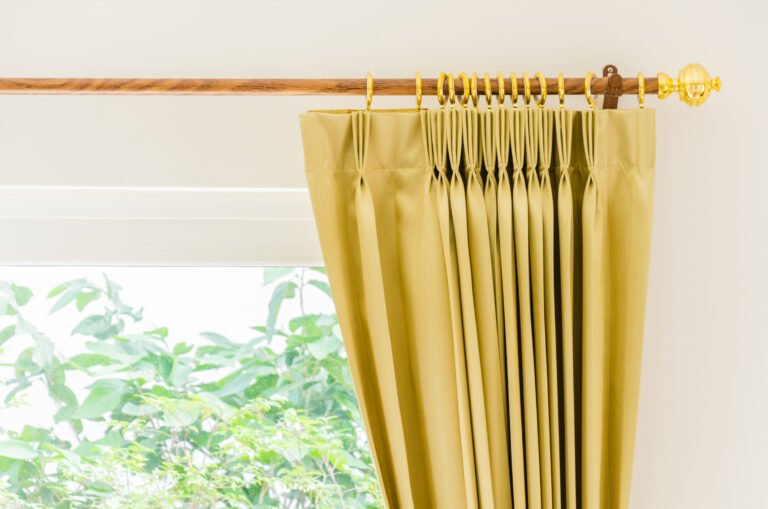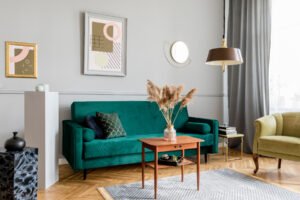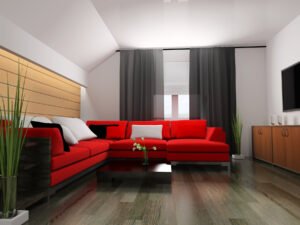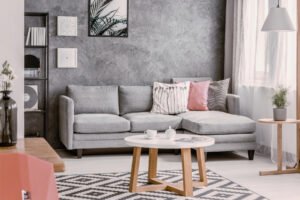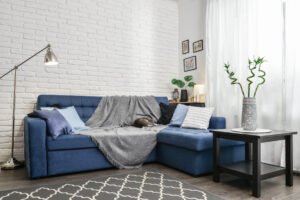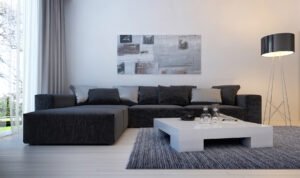Curtains are one of the most essential decorative elements in any space. These long fabric pieces not only offer privacy but also add a fashionable touch to the space. In a room with large windows, curtains cover a large portion of the canvas, so they must be flawless!
That’s why you must know and understand the various curtain types and their functionality before picking one for your home, And this ultimate guide on different types of curtains based on different criteria is exactly what you need!
Types of Curtain Based on Style
When choosing curtains for a room, it’s critical to understand the style it needs. Cafe Curtains, for example, are best if you want a functional and decorative curtain for your kitchen or drawing rooms. But if you want formal curtains for your living room, a panel pair is the way to go.
So, here are the most popular curtain styles with all the details.
1. Single Panel Curtain
Single-panel curtains have a single panel of fabric. The panel covers the entire window and can be easily opened by pulling to either side. These curtains are pretty functional and give a simple, minimalistic look. And if you have a wider window, go for a panel pair.
You can hang single panels straight with rod pockets, eyelets, tab-tops, or even rings. Or, you can even tie the panel curtain back on either side to give the room a more informal, misaligned look.
2. Panel Pair Curtains
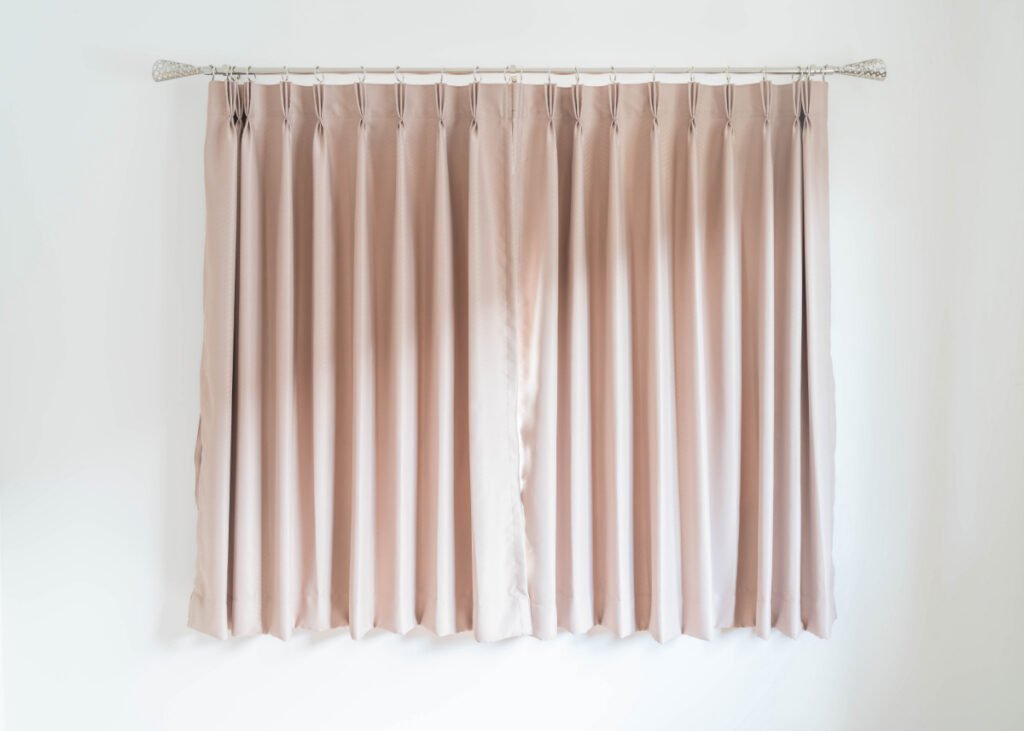
If your room has large windows, you might need a panel pair curtain. The panel pair comes with two panels that hang above the window on either side of the rod or bar. The curtains can be opened or closed by pulling them to opposite sides.
Panels have always been popular as they can gorgeously blend into almost any interior design style. When hung straight, these curtains look modern, and when tied with tiebacks, they create a traditional feel in the space!
3. Valance
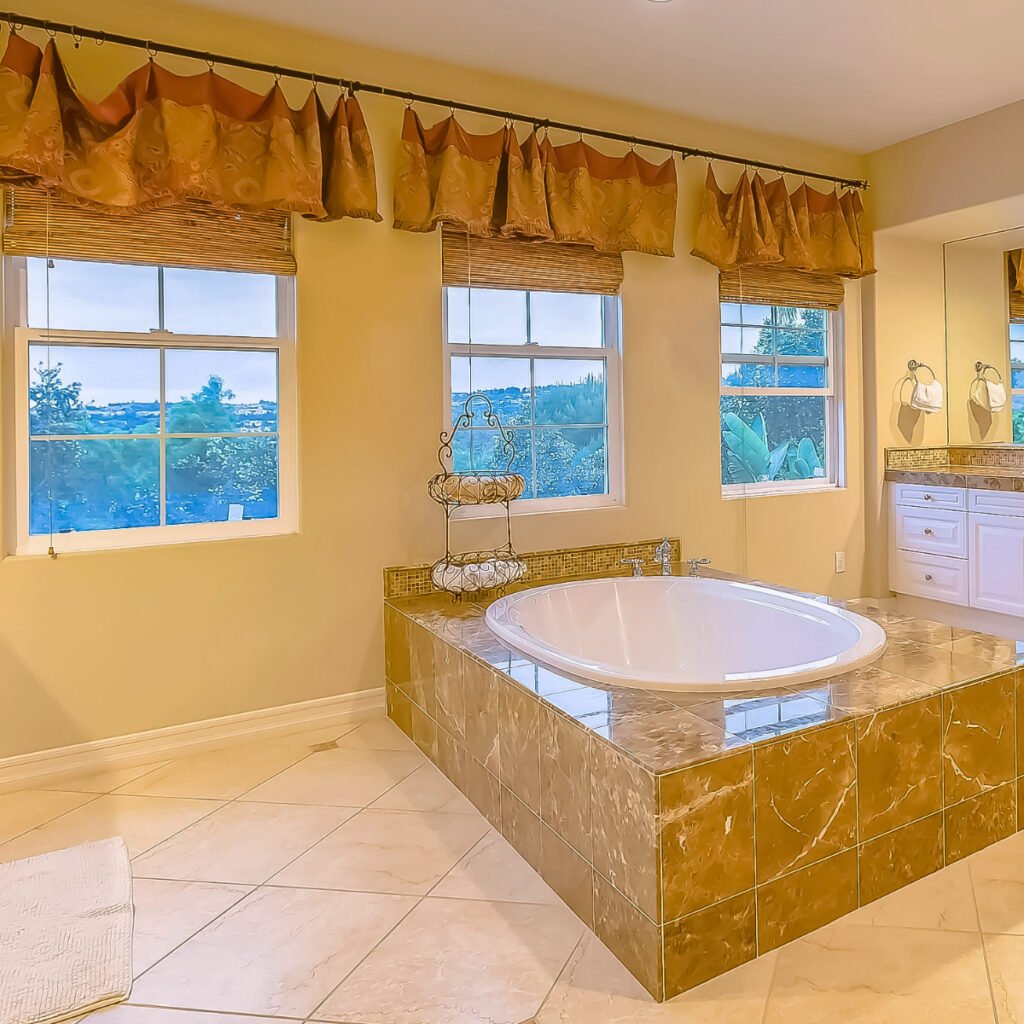
A valance is a short curtain fabric panel that hangs across the top half of the window and hence is popular as a Window Topper. This small curtain panel designs a neat look by covering the window treatment hardware like rods and hooks. You can use it singly or in combination with other window treatments or curtains!
While valances work best with rod pockets and hidden tabs, you can also staple them to the curtain board. It’s a quick tool to tie together the look of a room with different window blinds.
Available in popular styles like Straight, Arched, Cascade, Balloon, and Scalopped, a valance curtain can magically fit into various interior styles.
It’s best to pick the curtain colors and patterns based on your room’s entire decor. If the design sports neutral and solid colors, you can add an abstract touch with patterned curtains.
4. Window Tier or Cafe Curtains
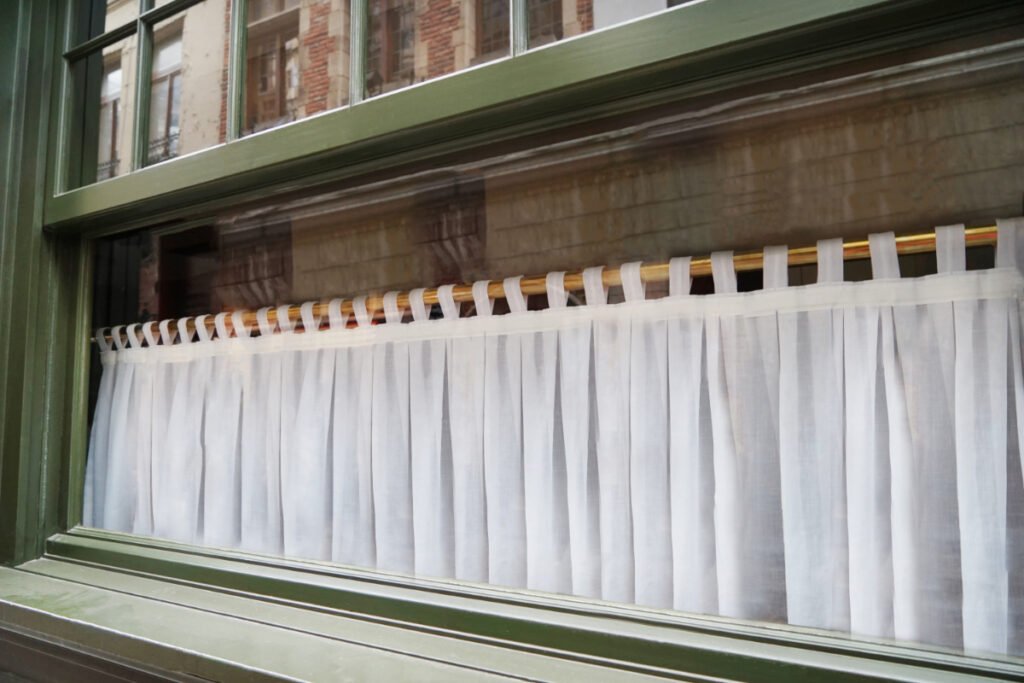
The window tier is a set of two or three short curtain panels typically hung in the middle of the window rather than the top, covering its lower half. This curtain set is best suited for areas like kitchens that need privacy as well as light. Popularly used in cafes and kitchens, these are also called Café Curtains.
The two curtain panels at the bottom can also be paired with a valance or swag on the top. The Café curtain gives an adorable, casual look and oozes friendly vibes into the space.
5. Window Swags
Swag can be considered a unique valance that’s less formal and gives your space a soft, relaxed vibe. It’s gathered pieces of fabric that loosely hang across the window’s topmost part wrapped around a curtain rod.
Swag curtains have excess curtain material that is styled in pleats or can be shirred. The middle of this curtain is short and hangs across the rod, while the ends casually hang down the length of the window on either side.
Generally, these can be used alone as decorative pieces for windows, but you can pair them with blinds or shades to maintain privacy!
6. Window Scarves
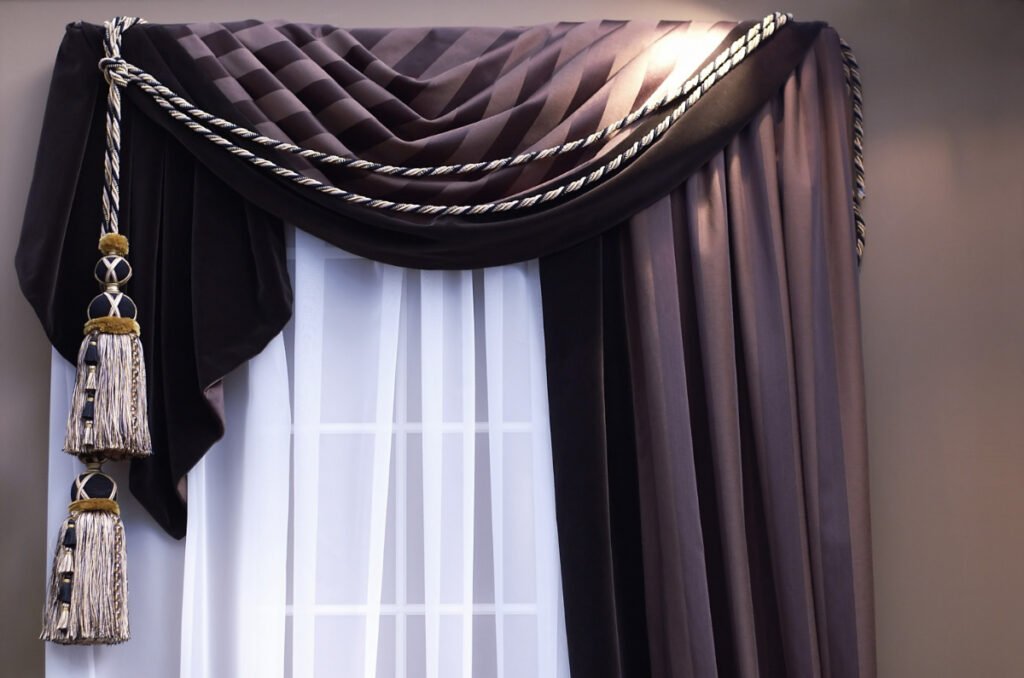
A window scarf is a long piece of curtain fabric draped around the window treatment rod like a scarf. It’s an unconventional curtain style as it doesn’t block light or offer privacy like a regular curtain!
It does, however, make an excellent, tasteful window decoration. And if you need to darken the room, you can use window scarves with blackouts or panels.
In terms of fabric, window scarves look best in soft, lightweight fabrics such as silk, chiffon, and velvet. And you can use these in living rooms, bedrooms, and offices for deluxe aesthetics!
7. Window Treatment Set
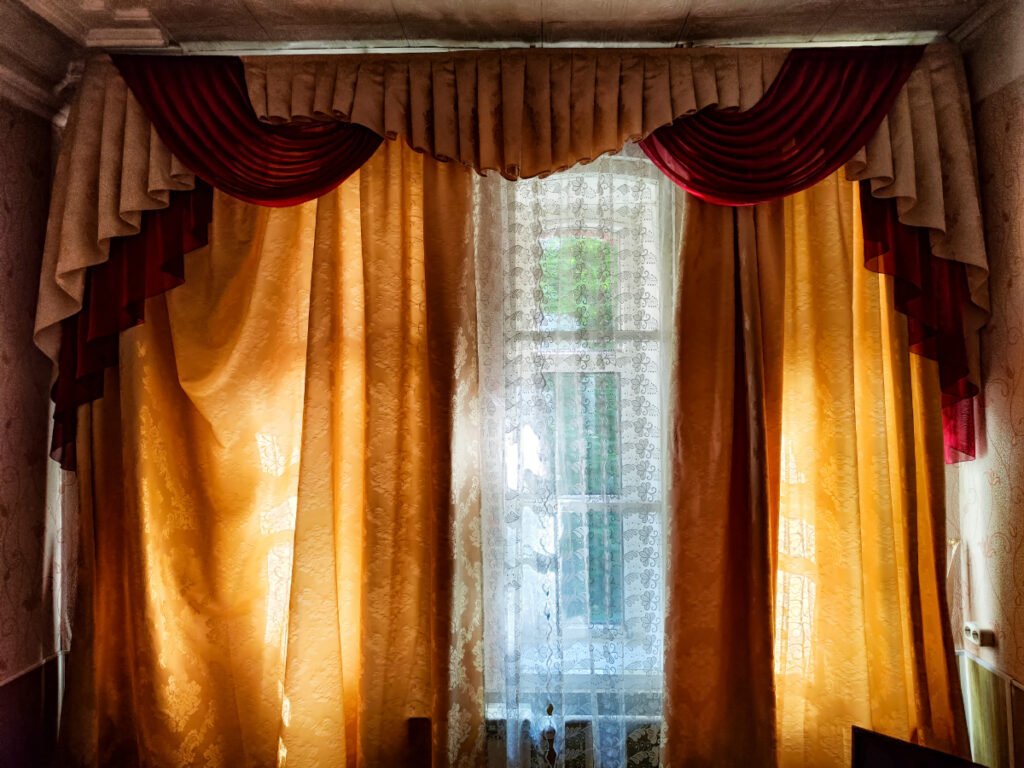
Simply put, a window treatment set is a complete curtain set for your windows! It includes a valance, swag or scarf, a single panel or panel pair, and sometimes, accessories like a curtain rod, hooks, and tiebacks. It’s the perfect option for cohesive interior decor with matching, integrated window treatment!
8. Curtain Liners
A curtain liner is a piece of fabric tacked to the back or insides of a curtain. It’s a functional rather than decorative type of curtain. Typically, the liners are sewn to the back of the curtain, but you can also hang them separately using the same hooks as for the curtains.
Curtain liners serve multiple functions, like privacy, light-blocking, insulation, and temperature control. If you want to keep your space warm, you can also get thermal curtain liners!
If you need more darkness and privacy in your room, a curtain lining can do that for you. However, since curtain lining makes the drapes heavier, choose the right shades to use liners with.
9. Roman Shades
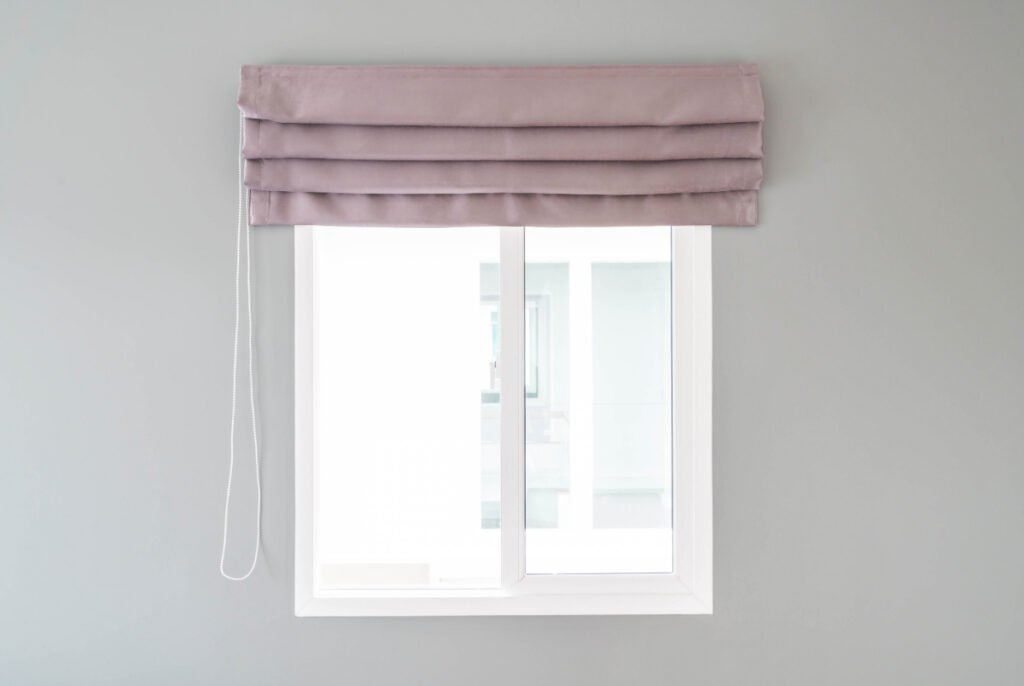
A Roman shade is primarily a single curtain panel that can be raised or lowered vertically to maintain light and airflow. When the shades are lowered, they resemble flat curtains, but when raised, the panel is folded using horizontal bars to form crisp, neat flat folds.
Roman shades can be hung using interior or exterior mount brackets that are easily installable. But since it’s a see-through curtain and may show the bars and cords, it’s best to use light fabric like cotton and linen for a Roman shade!
Roman shades suit many interior decor styles, be it contemporary, French-style, Countryside, or Vintage.
10. Priscilla Curtains
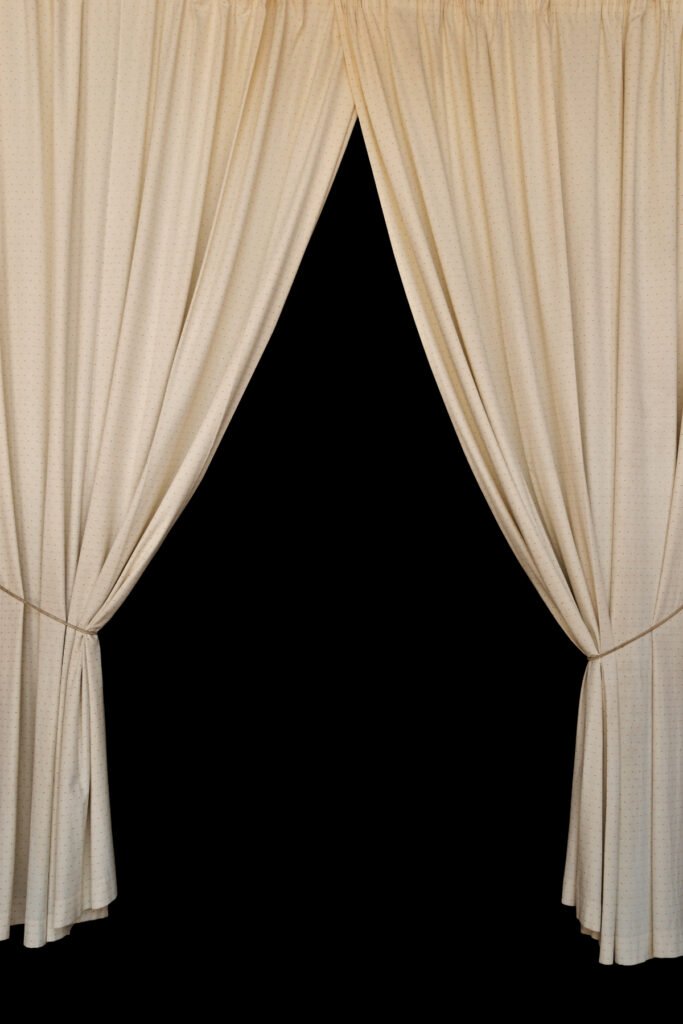
Priscilla curtains are the best tap to create vintage, romantic visuals in a room. These curtains feature soft, uniform riffles that run down the length of the curtain, bringing casual charm vibes. Mainly made from sheer, see-through fabrics, Priscillas are perfect for soft, laid-back countryside homes.
These curtains are hung on two curtain rods to attain the popular crossover on the top halves of the panels. You can also tie them on opposite sides with tiebacks to create a vintage silhouette look!
11. Balloon Shades
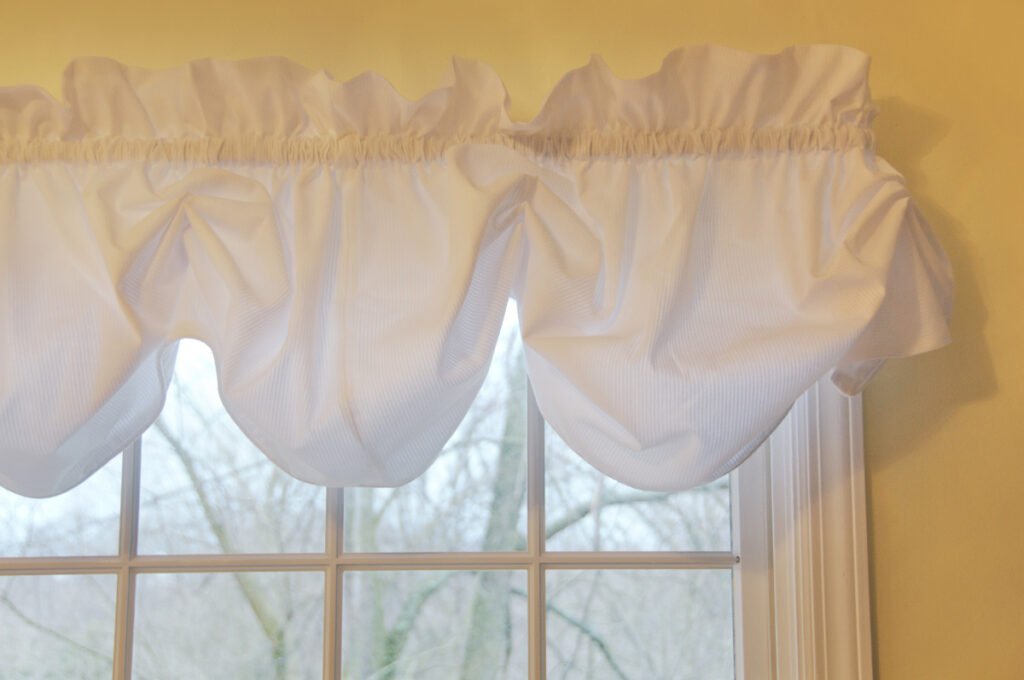
The balloon shade is a somber, traditional Roman-style curtain with scalloped swags or curved horizontal pleats that run the length of the curtain to the window sill or frame. You can raise or lower the curtain using the cord and ring system attached to the back of the shade.
When the shades are raised, the inverted pleats fold to form a fluffy balloon valance with soft curves or swags, looking luxurious!
Types of Curtains Based on Header Styles
The top piece of the curtain panels attached to the curtain track or rod is the curtain header. The header design gives the curtains their fullness and waves.
With different kinds of pleats and designs they are styled in, here are some most popular curtain types based on the header styles.
12. Ripple Fold Curtains
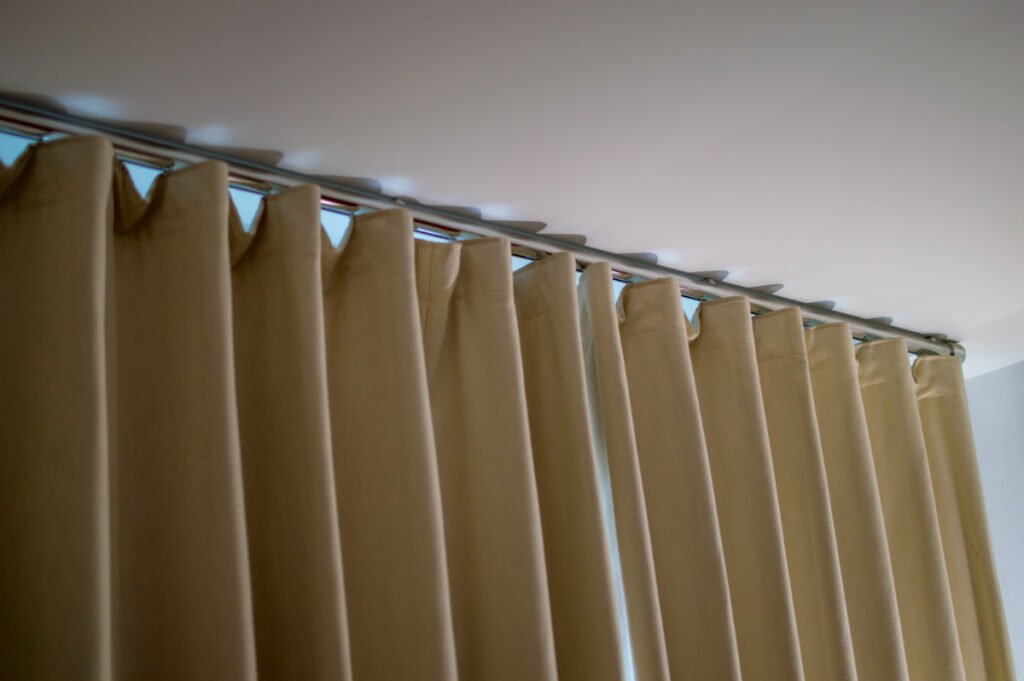
Ripple Fold or Flat Pleat drapes have uniform ripple or wave-like pleats across the panel when pulled together but appear completely flat when stretched. These clean ripples are formed by long cords connected to the carrier behind the panel.
The ripple fold drapery is usually hung below the curtain track with hooks and is very simple to slide, open, and close. Depending on the amount of fabric used, ripple fold curtains offer varying degrees of fullness.
The curtains are also supported by two types of carriers. The Overlap master carrier allows the two panels to overlap in the center, whereas the Butt master carrier creates a ripple effect.
To get the perfect curtain width, measure the width of your window frame, curtain track, or rod, and double it. If you want to estimate the curtain width for more than one panel, divide the doubled width by the number of curtains you want on your window.
13. Pinch Pleat Curtains
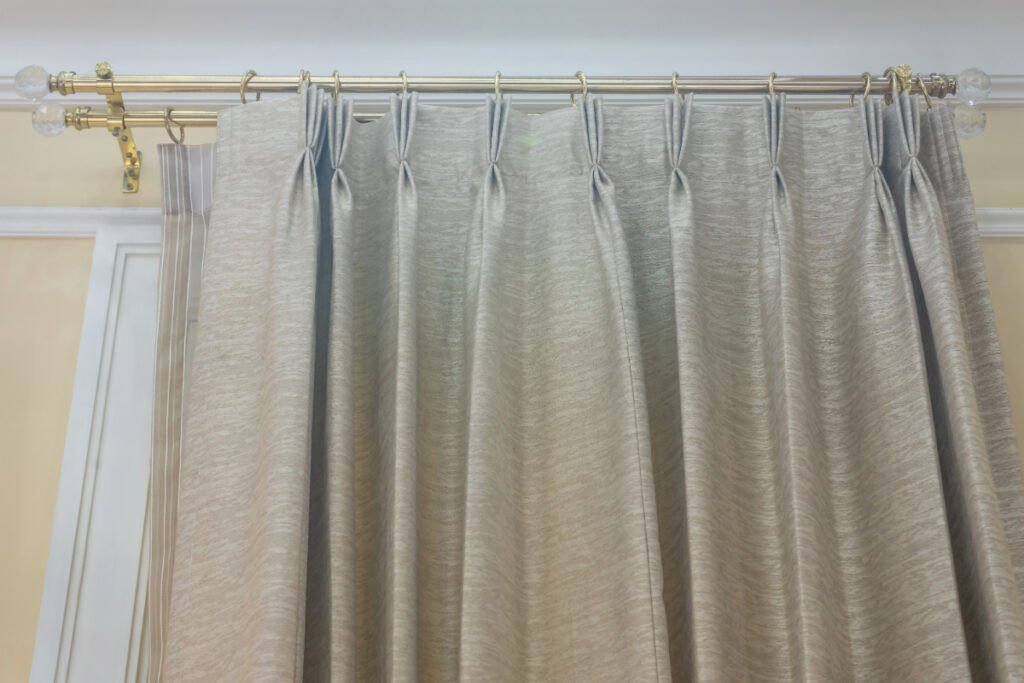
Pinch pleat curtains feature a classic, fashionable header with tightly packed pleats spaced evenly apart and permanently pinched a few inches down the top. These pleats flow down the length of the curtain, creating an elegant, wavy effect.
Pleat drapery is mostly made from heavy, textured fabrics and can be hung on a rod or pole using curtain rings and hooks.
Based on the number of folds sewn together, pinch-pleated curtains can have two to five fingers (or folds) in each pleat. The three-finger pleat or the French pleat is the most popular pleat curtain header style for a traditional interior!
14. Goblet Pleat Curtains
A goblet pleat curtain is a decorative pinch pleat curtain with a stylish header resembling a goblet or wine glass. Above the cinching point, the pleats are folded in a cylindrical shape, giving it the classic goblet look! Mostly made from thick fabric, these drapes look highly formal and intense!
However, a goblet pleated curtain is relatively less functional and flexible than pinch pleat curtains as they must stay in place because of a delicately designed header. So, it’s best to use them for decorative purposes in areas that don’t need much curtain movement!
15. Pencil Pleat Curtains
A pencil pleat curtain has narrower, jagged folds sewn several inches below the curtain top. The folded pleats in these curtains look like rod pocket curtains, but they are fixed and mostly attached to the rod with hooks.
Unlike pinch pleat curtains, a pencil pleat panel looks flatter and adds a casual vibe for friendlier spaces like living rooms, bedrooms, and dining rooms.
16. Tailored Pleat Curtains
Tailored pleat curtains, also popular as European Pleat Curtains, are similar to pinch pleat curtains except that the pleats in Tailored panels are tacked at the very top, and the folds flow elegantly from top to bottom. These curtains fit in well with classy, contemporary home decor!
Each pleat in the tailored curtains is attached to a hook or ring that can be hung on the curtain track or the conventional curtain rods. When made with heavy, thick fabric, this curtain exudes elegance and sophistication in the space!
17. Butterfly Pleat Curtains
A butterfly pleat curtain is a variation of a pinch pleat curtain. It has uniform folds that are tacked a few inches below the top of the buckram, creating a gorgeous, fluffy butterfly pleat.
Depending on the look you want, you can choose two, three, or more folds per pleat for this curtain. Furthermore, this unique pleat style works best with soft, light, to medium-weight fabrics such as silk, linen, velvet, and cotton.
18. Box Pleat Curtains
Box pleat curtains feature clean rectangular or box-shaped pleats that are cinched a few inches below the curtain top. These pleats flow down neatly, giving it a formal look!
With their sleek arrangement and cinching of flat pleats, box pleat curtains create a crisp and modern decor. But because the box pleats are stiffly sewn in place, these curtains are not flexible enough to be moved frequently!
19. Inverted (Box) Pleat Curtains
Inverted pleat curtains, like box pleat curtains, have rectangular pleats, but because the pleats are inverted, the fullness is turned inwards, making the curtains appear flat from the front. This drapery looks formal and complements modern home decor, creating more depth and dynamism!
Curtain Types Based on Attachment Style
Curtain styles differ not only by the panel design but also by how the panels are attached to the traverse rods or tracks. Below are some popular curtain types based on the attachment styles.
20. Grommet & Eyelet Panels
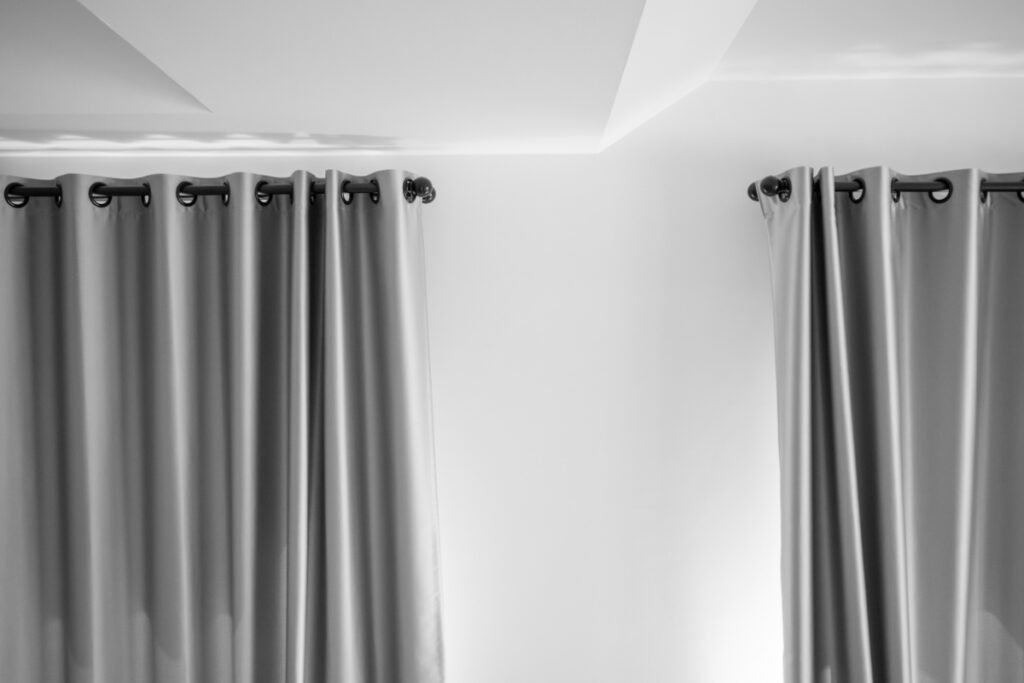
Grommet curtains are usually hung on curtain rods with metallic rings or grommets that are punched into the top of the panel. When the curtain is pleated, these rings align and slide onto the curtain rod, hiding all window treatment accessories.
Moreover, since the curtain’s weight is put on the rod through built-in rings, this curtain style works best for heavier fabrics.
21. Cubicle Curtains
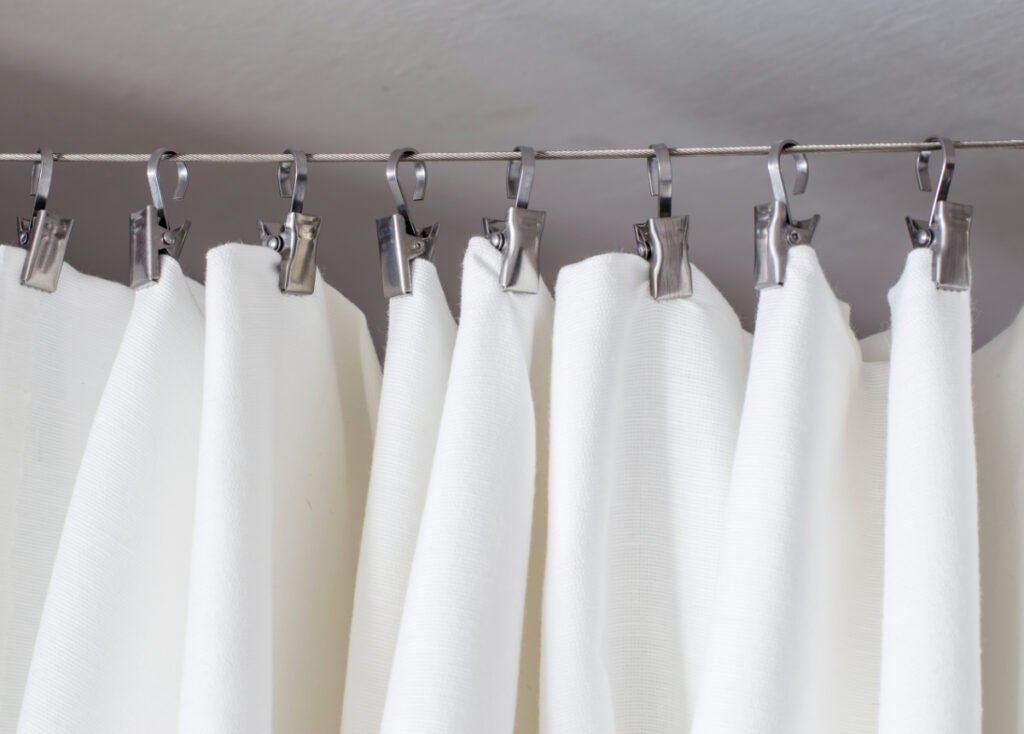
Have you seen those curtains used in hospitals or therapy clinics for the private enclosure? Those are cubicle curtains.
A cubicle curtain can be considered a cross between ripple fold and grommet curtains. This drapery has tiny built-in metallic or plastic grommets/eyelets on the panel’s top, which are then attached to the curtain track using hooks.
Like ripple fold curtains, this curtain style appears full when gathered but flat when stretched across the track, giving it an extremely minimal feel!
Cubicle curtains have the unique ability to glide smoothly down a bent or curved track. So you can also hang them around your bed using a curved cubicle track on the ceiling. Interesting, right?
22. Rod – Pocket Curtains
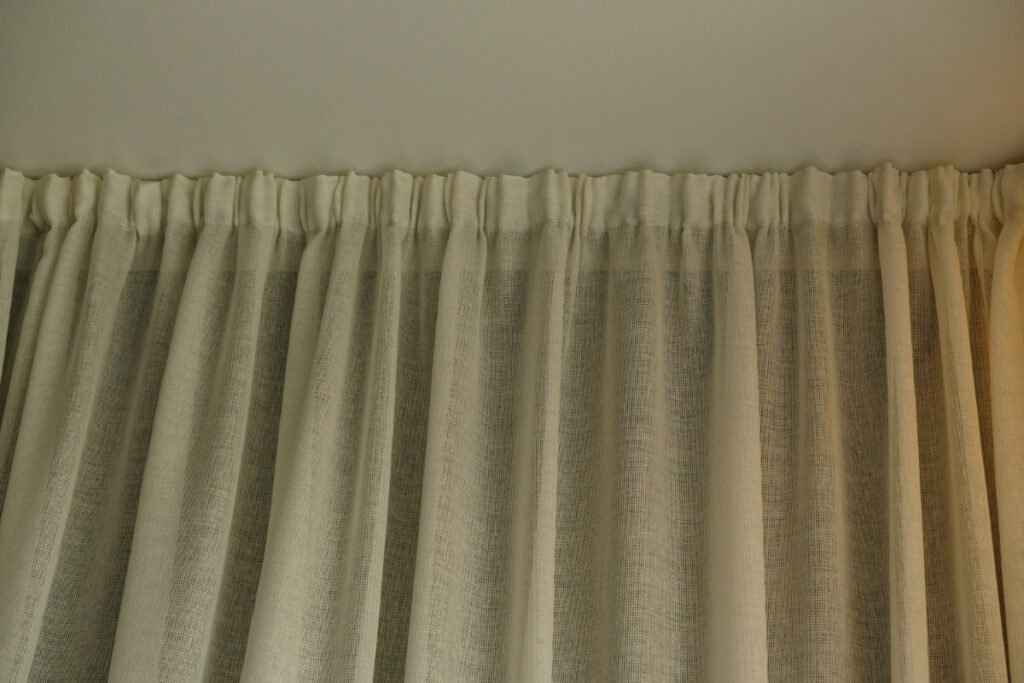
Like Grommet curtains, a rod pocket curtain can slide onto the curtain rod or bar via a pocket designed on the top of the curtain panel. This rod pocket is made from the same fabric as the curtains and boasts a simple, clean vintage look!
But this attachment style is a bit frictional, which is why rod-pocket panels are best used in rooms where curtains are not opened and closed frequently!
23. Tab-top Curtains
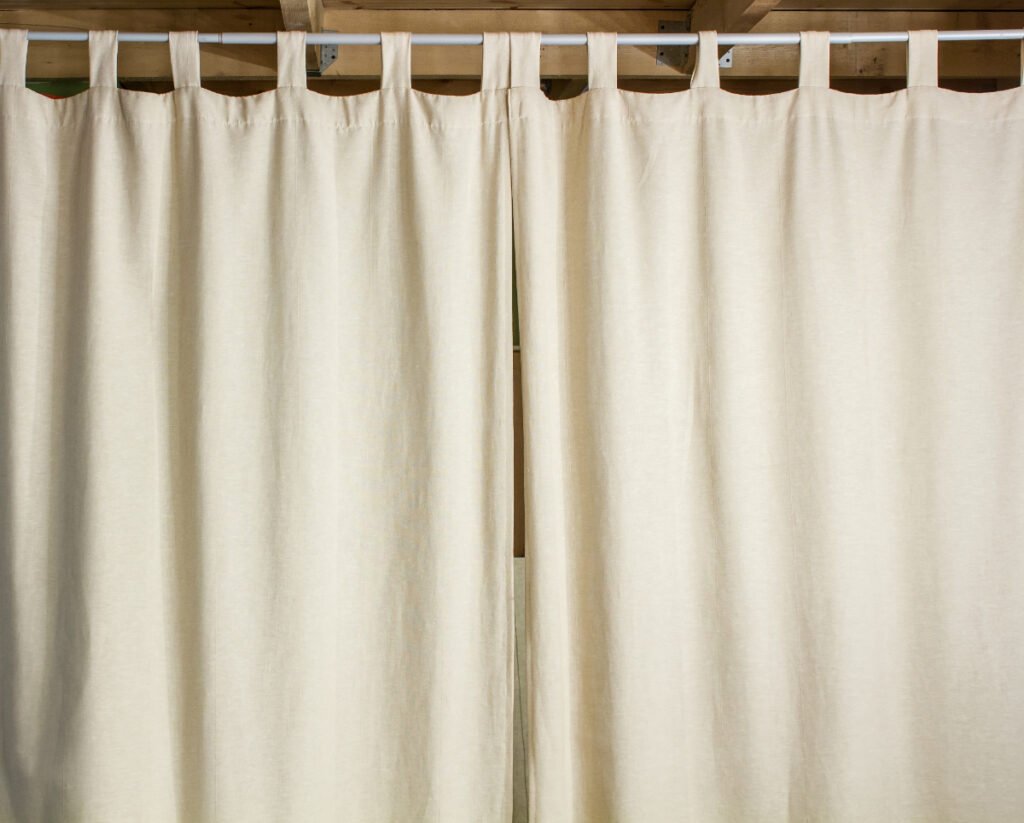
Tab-top curtains feature fabric loops that are sewn at the top edge of the curtain. You can simply slide the curtain rod through the loops to hang the curtain. Since the loops are made from the same or similar fabric as the curtain, a tab-top curtain looks creative and cohesive!
Based on how the loops are designed, the tab-top curtains are available in different styles such as Knotted Tab-tops, Twisted Tab-tops, etc. You can jazz them up more by adding decorative buttons at the bottom of the loops.
24. Tie-Top Curtains
Tie-top curtains are knotted around the curtain rod with the help of fabric strips attached to the curtain. Because these curtains hang below the rod, the hardware behind them will be easily visible. With a soothing, casual appearance, this curtain style will look fantastic in informal spaces and kitchens.
Furthermore, due to their delicate attachment style, tie-top curtains work well with lightweight curtain fabrics such as sheer.
25. Hidden Tab Curtains
Hidden tab curtains have tabs or loops designed on the backside of the panel’s top. As such, these curtains are also popular as Back Tab curtains. This style is another excellent option to hide the window treatment hardware!
To determine the right curtain rod length, measure the width of your window frame and add 3-6 inches (depending on your preferred look) on both sides. A long curtain rod allows the curtains to cover the entire window while giving enough space to move the curtains when you open them.
Types of Curtains Based on Fabric Opacity
Besides sprucing up the interiors, a window curtain darkens rooms by covering the windows. The thicker the curtain fabric, the more light it jams. Depending on the fabric thickness and opacity, here are some curtain types you must know of.
26. Sheer Curtains
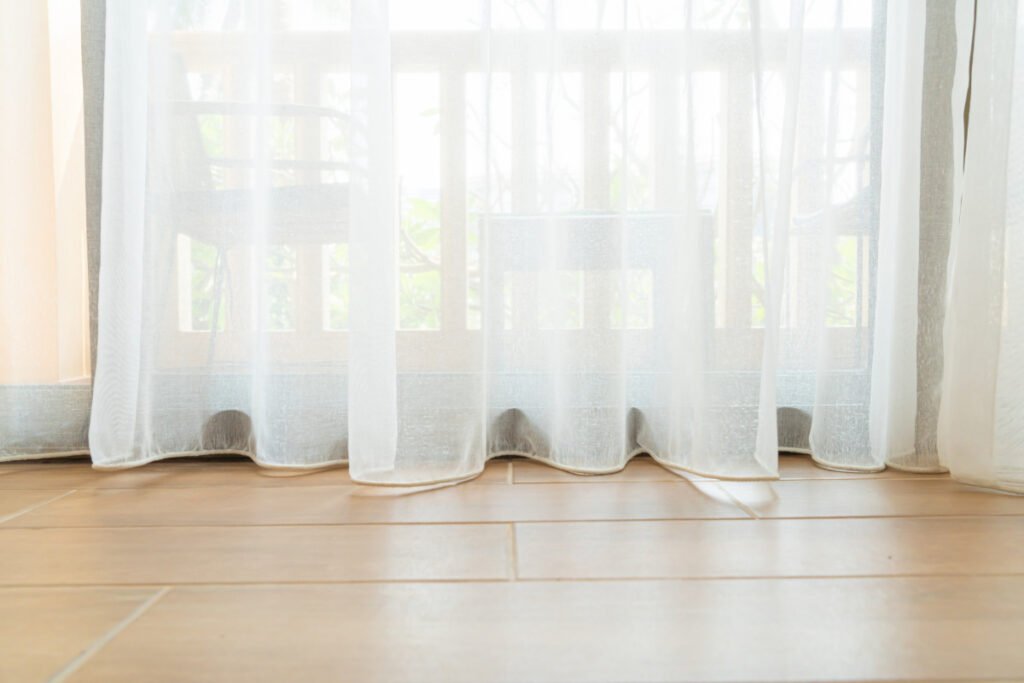
Sheer curtains or sheers are light, airy drapes made from a lightweight fabric that introduces softness into the space. These see-through curtains allow ample natural light, keeping your space bright and ventilated. If privacy is not your first concern, sheers are the perfect modern decorative drapery for you.
However, for better privacy and lighting control, you can layer a sheer curtain with blackouts. Nonetheless, see-through sheer curtains look elegant in almost any interior style!
27. Semi-Sheer Curtains
Semi-sheer curtains provide more privacy than sheers. They don’t significantly block the light, keeping your room sufficiently bright, but they’re not exactly see-through. You can go for colored sheer curtains or lace curtains for this purpose.
However, with the lights turned on, these curtains will not help much at night, and you may need to pair them with thick drapery for privacy.
Linen and Cotton curtains are the best options if you need your room to be moderately bright.
28. Semi-Opaque Curtains
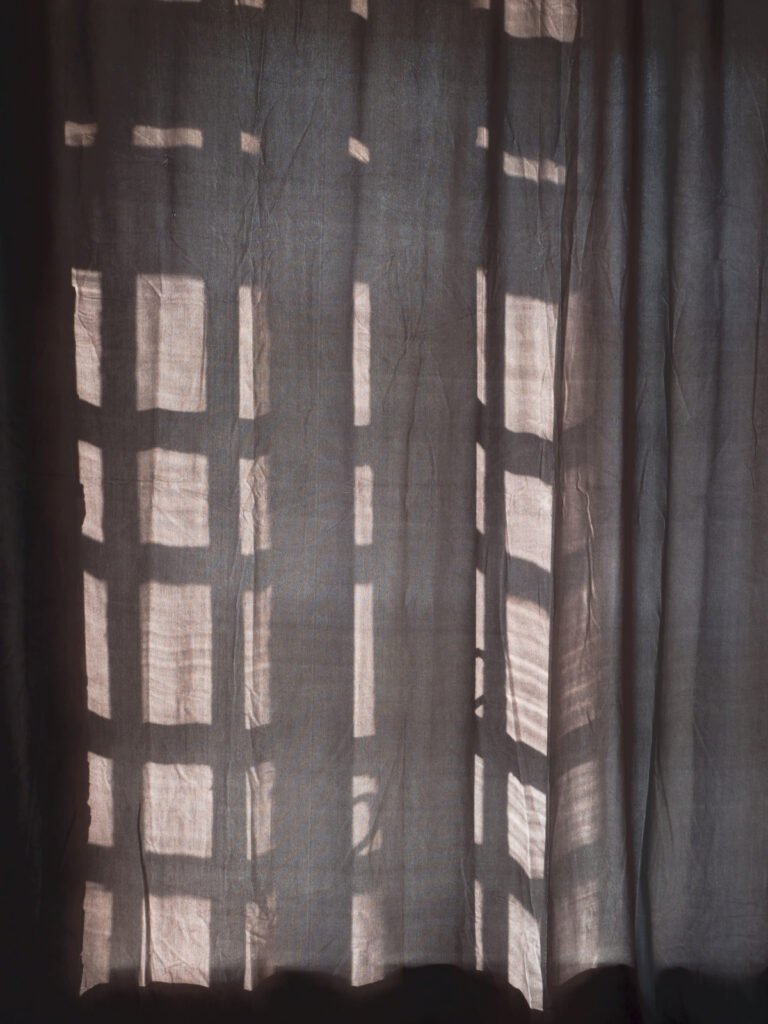
Semi-opaque curtains are the standard curtain types that fall between sheers and blackouts. Although you won’t be able to see through these curtains, the room will be adequately lit.
Semi-opaque shades work best with linen, cotton, silk, and synthetic fabrics. You can consider Roman shades, pleated curtains, or panel drapery styles for a semi-opaque look.
29. Opaque Blackout Curtains
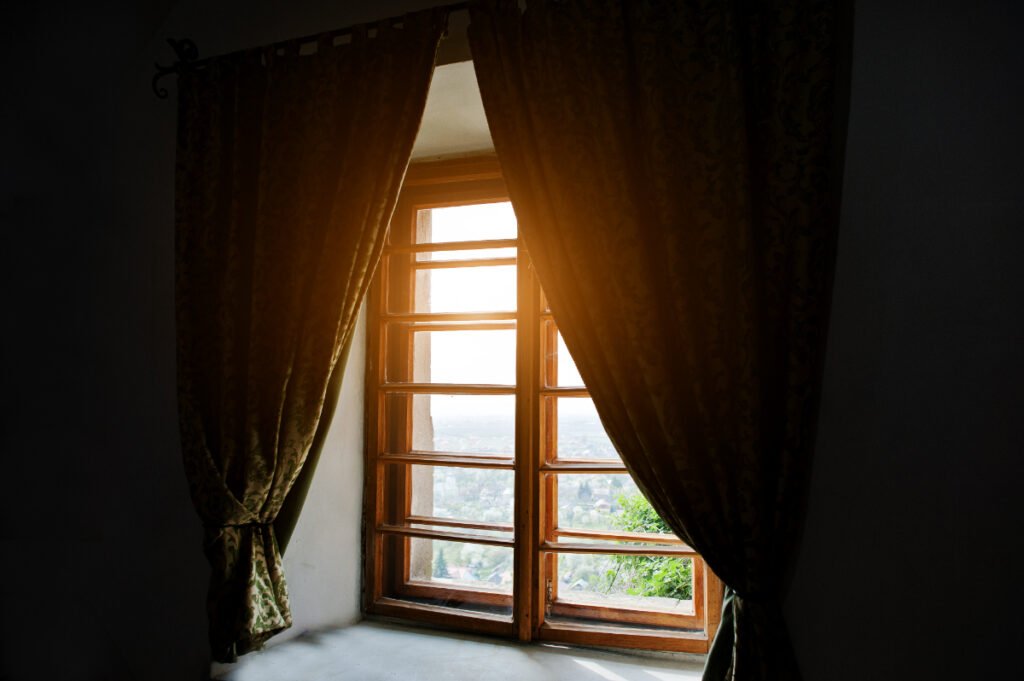
Opposite sheers, a blackout curtain ensures maximum privacy and lighting control in any space. These curtains are made of heavy tightly-woven fabric that blocks nearly 100% of the light, oozing a perfectly dim, cozy ambiance for private spaces like bedrooms.
Some blackout curtains also have curtain liners for added opacity and insulation. You can also pair them with sheers for a layered, refined look!
Go for polyester or nylon blackout curtains to let minimal natural light into the room. Velvet is another material that can provide maximum light and privacy control while also adding a touch of luxury to the space.
Different Curtains Based on Length
The length of a curtain panel plays a crucial role in designing the room’s entire look. So, it’s essential to pick the right size of curtains! Check out the most common curtain types based on the panel length.
30. Window Sill-Length Curtains or Tier Curtains
Window sill curtains hang from above the window frame and stop at the window sill or just above it. These curtains look less formal and bring a nonchalant, homey vibe into the space.
Sill-length shades are ideal for kids’ rooms, living rooms, or kitchens with small windows that need some space beneath for fixtures or other items!
31. Apron/Floating Curtains
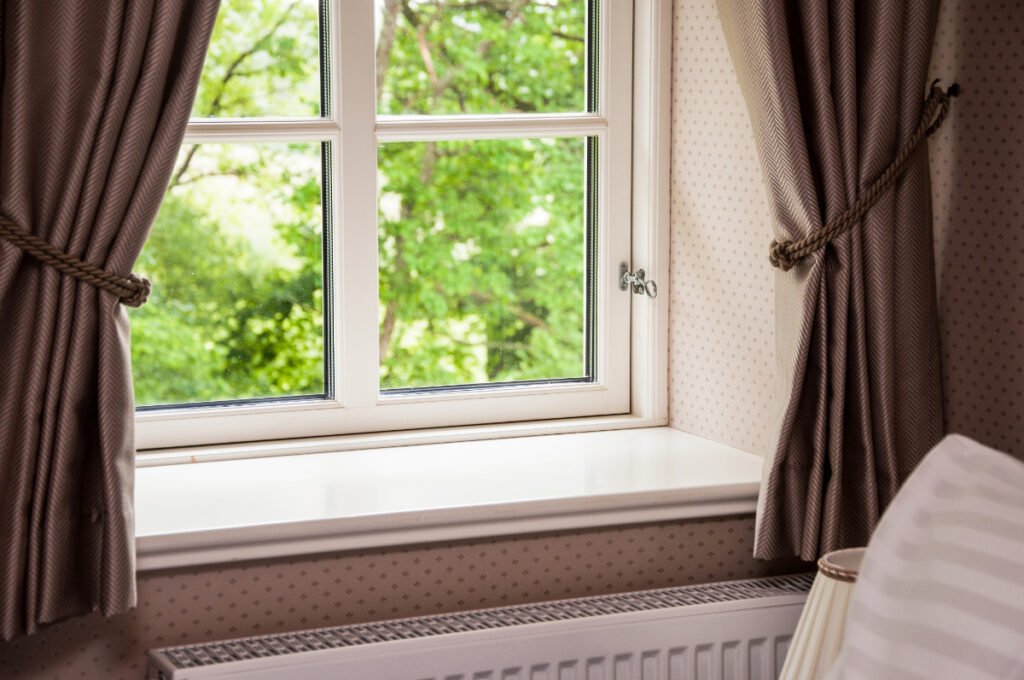
Apron curtains or floating curtains hang a few inches below the window sill along the length of the window apron. They look best on elevated windows in small rooms, giving a light and airy feel.
These shades leave plenty of space below the window and work best for bedrooms or living rooms with radiators beneath the windows. And since they don’t cover the entire wall length, you can also show off your wall decoration!
32. Floor-length or Kiss-the-Floor Curtains
The floor-length curtains hang down, brushing or kissing the floor. You can hang them directly above the window frame or at the top of the wall to cover multiple windows. These curtains work well in living rooms, bedrooms, and hallways, giving a formal and cozier feel to the space!
Floor curtains should be between 84 and 96 inches long. It’s best to keep the curtain length just a few inches above the floor for ease of cleaning and frequent curtain movement.
33. Puddle Length Curtains
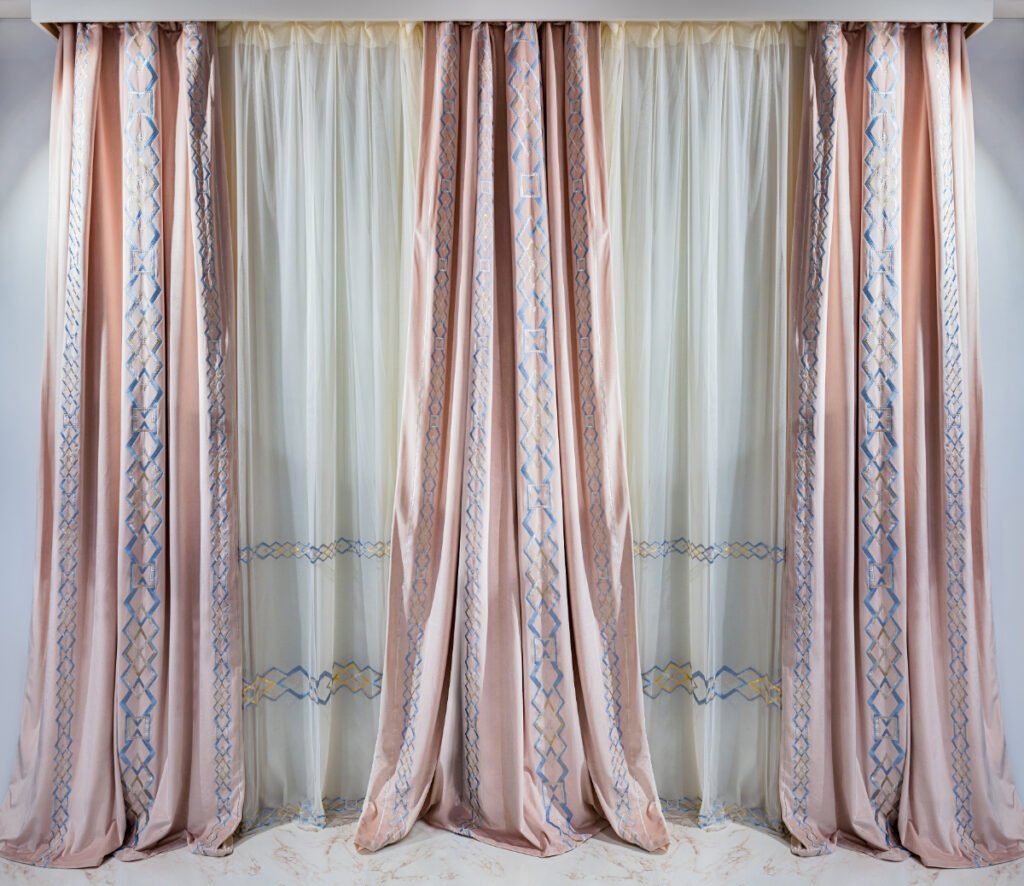
Puddle-length curtains are extended panels that create a puddle of fabric on the floor. These curtains appear more formal, but they also add a romantic character and flair to the space. Depending on how fluffy a puddle you want on the floor, there are various puddle lengths.
Break puddle is the shortest puddle curtain, with ½ – 1 inch of extra fabric that deviates from the traditional look of standard curtains. Medium puddle curtains have 2 – 4 inches of extra fabric, whereas true puddle curtains have 6-18 inches of extra fabric fanning out on the floor.
Should curtains touch the floor?
Yes, your curtains should reach the floor if you want a decorous, classy look in your home. Floor-length curtains are an excellent way to add layered, refined visuals to a space. But, for easy cleaning, you can keep your curtains 1/2 inches above the floor. However, refrain from using floor-length curtains in kitchens or bathrooms because they can become messy and difficult to maintain.
Should curtains touch the window sill?
Although there’s no hard rule, it’s best to keep the window curtains ½ inches above the window sill to achieve a friendlier and less formal interior. Especially, a kitchen curtain looks the best in sill length.
How much longer should the curtains be than the window?
It is determined by your needs and desired appearance. If you want to add decorative curtains to your kitchen and living rooms, you can go with sill-length, apron-length, or cafe curtains, but if you want a more elegant and formal ambiance, floor-length or break puddle curtains are the best choice.
What length should the curtains be in a bedroom?
Floor-length curtains work best in a bedroom for an elegant, visually appealing decor. You can even use puddle curtains to design a more homey, romantic atmosphere in your private space.
Should all bedrooms have the same curtains?
No, there is no hard and fast rule that all bedrooms in a house must have the same curtains. Instead, the curtains should reflect the people who will be using the room as well as the type of interior style desired in the room.
Which curtain heading uses the most fabric?
Generally, all pleated curtains require a good amount of curtain fabric, but triple pleat and butterfly pleat curtains require the most fabric to achieve their lovely full appearance.
Curtains can make or break the aesthetics of a room, so choosing the right curtain type based on the space and people’s needs is critical. So, use this guide to learn everything about the different types of curtains in the market and choose the most suitable ones for your home!
Throw pillows are another decorative accent piece that adds a finishing touch to the space. Join us here to learn about different types of throw pillows and how to choose the best ones for your upholstery.

